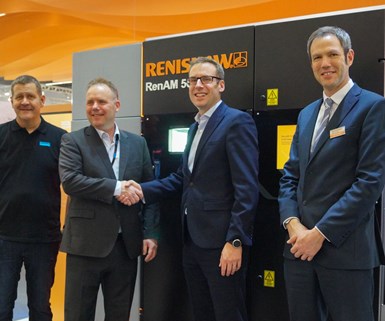Renishaw, Sandvik Collaborate on Validating AM Materials
Since 2018, the two companies have worked together to develop process parameters for a range of Sandvik metal powders.
Share






Renishaw is collaborating with Sandvik Additive Manufacturing to qualify new additive manufacturing (AM) materials for production applications. The project encompasses a range of metal powders, including new alloy compositions that are optimized for the laser powder-bed fusion (LPBF) process.
Since 2018, the two companies have worked together to develop process parameters for a range of Sandvik metal powders, including stainless and maraging steels and Osprey nickel-based superalloys. Sandvik has recently launched a titanium atomizer and powder processing facility and will now turn its focus to qualifying these alloys for industrial and medical applications.
Mikael Schuisky, vice president of R&D and operations with Sandvik Additive Manufacturing, says, “Renishaw’s open machines have enabled us to rapidly optimize process parameters for our alloys for use in many different applications.” The company says that this parameter development work has highlighted opportunities to make small but important changes to the composition of Sandvik alloys while remaining within the relevant ASTM specification, thus optimizing the mechanical properties of LPBF components.
“Much of the innovation in AM in the next few years will come from the pairing of enhanced machine performance with improved alloys,” says Stephen Crownshaw, AM business nanager with Renishaw. “Better alloys mean better material properties, enabling AM components that are even more efficient and cost-effective.”
Related Content
-
In Moldmaking, Mantle Process Addresses Lead Time and Talent Pool
A new process delivered through what looks like a standard machining center promises to streamline machining of injection mold cores and cavities and even answer the declining availability of toolmakers.
-
The Benefits of Vertically Integrating Metal 3D Printing and Machining
Having 3D printing and machining within one organization enables Addman’s engineers to collaborate and consolidate so it can quickly make successful metal 3D printed parts.
-
Additive/Subtractive Hybrid CNC Machine Tools Continue to Make Gains (Includes Video)
The hybrid machine tool is an idea that continues to advance. Two important developments of recent years expand the possibilities for this platform.























